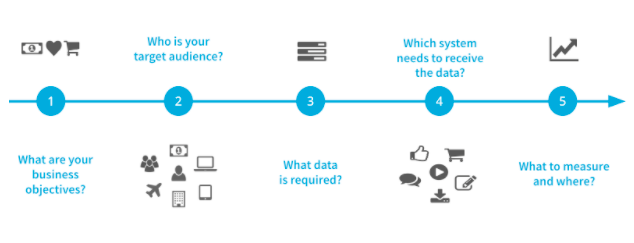Understanding First-party Data Strategy
A first-party data strategy is essential for businesses seeking to enhance their marketing efforts and customer relationships. This strategy revolves around collecting and utilizing data directly from customers through owned channels, such as websites, apps, and CRM systems. Implementing a robust first-party data strategy can lead to improved personalization, higher conversion rates, and stronger customer loyalty.
Step 1: Define Your Goals
Importance of Goal Definition
Before embarking on your first-party data journey, it’s crucial to define clear objectives. What do you aim to achieve? Whether it’s increasing sales, improving customer service, or enhancing user experience, your goals should be specific and measurable. Align these goals with your overall business strategy to ensure that your data efforts are impactful and relevant.
Setting Measurable Objectives
- Increase Cart Size: Aim for a specific percentage growth in average transaction value.
- Enhance Customer Experience: Set targets for customer satisfaction scores.
- Boost Conversion Rates: Establish benchmarks for lead-to-sale conversion ratios.
Step 2: Identify Valuable Data Sources
Mapping Your Data Landscape
To build an effective first-party data strategy, identify where your data will come from. This includes various channels such as:
- Website Interactions: Analyze user behavior on your site.
- Mobile Applications: Collect data from app usage and interactions.
- Email Campaigns: Track engagement metrics from newsletters and promotions.
Ensuring Data Quality
Data quality is paramount. Implement guidelines to ensure that the data collected is accurate, relevant, and up-to-date. Regular audits can help maintain data integrity.
Step 3: Build Customer Trust
Earning Trust Through Transparency
Trust is a critical component of any successful first-party data strategy. Ensure that your customers feel secure about sharing their information by being transparent about how their data will be used.
Strategies for Building Trust
- Clear Privacy Policies: Provide easily accessible information about your data practices.
- Opt-in Mechanisms: Use consent forms that allow customers to control their data sharing preferences.
Step 4: Implement Effective Data Collection Methods
Techniques for Data Collection
Utilize various methods to collect first-party data effectively:
- Surveys and Feedback Forms: Encourage customers to share their preferences directly.
- Website Analytics Tools: Use tools like Google Analytics to track user behavior.
- Incentivized Data Sharing: Offer discounts or rewards in exchange for customer information.
Focus on Consent and Transparency
Always prioritize obtaining explicit consent from users before collecting their data. This not only complies with regulations but also fosters trust.
Step 5: Activate Your Data Across Channels
Utilizing Data for Marketing Efforts
Once you have collected valuable first-party data, it’s time to activate it. Use the insights gained to inform marketing strategies across various channels:
- Personalized Email Campaigns: Tailor content based on user preferences.
- Targeted Advertising: Use customer segments to create more relevant ads.
- Dynamic Website Content: Adjust website elements based on user behavior.
Step 6: Measure Impact and Optimize Your Strategy
Regular Review and Optimization
A successful first-party data strategy requires ongoing evaluation. Regularly assess the effectiveness of your initiatives against the defined goals.
Key Metrics to Monitor
- Customer Retention Rates: Analyze how well you retain customers over time.
- Return on Investment (ROI): Measure the financial impact of your data-driven campaigns.
- User Engagement Levels: Track how engaged users are with personalized content.
Implementing a first-party data strategy is a journey that requires careful planning and execution. By defining clear goals, identifying valuable data sources, building trust with customers, implementing effective collection methods, activating your insights across channels, and continuously optimizing your approach, businesses can leverage first-party data to drive growth and enhance customer relationships. Embrace this strategic approach today to stay ahead in the evolving digital landscape.

